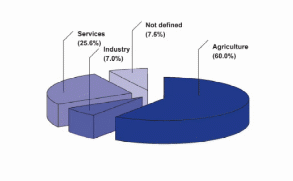Introduction
This report discusses child labor as a global issue challenging families today. Its linkage to globalization is discussed and some solutions to this issue are offered.
Child Labor Description
According to the International Labor Organization (2013), children engage in different tasks but not all these tasks constitute child labor. The organization describes child labor as “work that deprives children of their childhood, potential and dignity, and that is harmful to their physical and mental development” (p. 1). Furthermore, details reveal that this kind of work interferes with the social and moral development of children. This happens through interference of children’s school attendance whereby children stop attending school prematurely or combine school attendance with too much work (International Labor Organization, 2013).
The criteria for determining child labor comprises the following: “the child’s age, the type and hours of work performed, the conditions under which it is performed, and the objectives pursued by individual countries” (International Labor Organization, 2013, p. 1). This therefore means that child labor varies from country to country. However, there are extreme forms which cut across the board as clarified by Article 3 of ILO Convention No. 182.
Child labor is common in the agriculture and services sectors as shown in the diagram below.

According to statistics, child labor is still a big challenge. According to International Labor Organization (2010), more than 200 million children around the world are enslaved to child labor. More than half of these children are engaged in the worst forms of child labor described in Article 3 of ILO Convention No. 182. Although boys are said to form a statistical bulk of the child labor population, the contribution made by girls in domestic chores is often ignored. Child labor is intense in sub-Saharan Africa, followed by Asian-pacific regions, and Latin America and the Caribbean (International Labor Organization, 2010).
Child Labor and Globalization
Globalization has been noted to have a significant negative effect on child labor. This has been especially the case in developing countries. One case that came to limelight recently is that of children being forced to work in cocoa farms picking cocoa beans in West Africa. The children were reportedly trafficked from the countries of Mali and Burkina Faso and taken to work in cocoa farms in Ghana and the Ivory Coast.
The West African cocoa farms on which these children worked are the leading in the production of cocoa in the world market. Cocoa is the main ingredient in the production of “chocolates, candy, cookies and cocoa butter” (Aaronson, 2007, p. 1). Globalization has greatly connected the world into a single marketing region and consequently expanded the market for various businesses. The greed to make more profits has pushed businesses in West Africa to opt for cheap labor by enslaving children to work in the farms.
Apart from being trafficked to work in farms as seen above, children are also forced to enter the prostitution business. Trafficking of children for pornography and sexual exploitation is a problem experienced in the US. Mostly children are trafficked into the US for various forms of sexual exploitation (Hughes, 2002). In Asia children make a significant contribution to commercial sex trade: “30 to 35 percent of all sex workers in the Mekong sub-region of Southeast Asia are between 12 and 17 years old” (IRIN, 2013, p. 1).
Kaufman and Rizzini (2002) present a general argument on how globalization is linked to child labor. They argue that globalization has widened the equality gap. The negative effect of this gap is most felt in developing countries. In most of these countries, a significant portion of the population is classified as poor. In such conditions, most families cannot afford to educate their children and instead they let them work to make a contribution towards sustaining their families (Kaufman and Rizzini, 2002).
Child Labor Solutions
Child labor is a global issue and any proposal to solve this challenge must incorporate a global perspective. Most countries in the world are committed to eliminating child labor but their commitment needs to be reinforced. These can be done by imposing economic sanctions on those countries which seem to display laxity on their commitment to elimination of child labor. Imposition of economic sanctions is a technique which has been tried before and proved to work when there is a need to make countries align their policies to globally desired policies.
Another way of eliminating child labor is by encouraging multinational corporations to ensure that their supply chains do not involve child labor at any points. Multinationals have a strong influence in developing countries and they can easily influence the manner in which their partners undertake their businesses.
Conclusion
Child labor is a great global challenge which needs to be tackled from a global perspective. Statistics show that a huge percentage of children are engaged in child labor. Globalization is significantly linked with perpetrating child labor. This is widening the equality gap and opening up channels for children trafficking for forced labor and sexual exploitation. Solutions to child labor challenge have to incorporate a global perspective for it to be effective.
References
Aaronson, S. A. (2007). Globalization and Child Labor: The Cause Can also be a Cure. Yale Global Online. Web.
Hughes, D. M. (2002). Trafficking of Children for Prostitution. US Department of Justice.
International Labor Organization. (2010). Facts on Child Labor. International Labor Organization. Web.
International Labor Organization. (2013). What is child labor. International Labor Organization. Web.
IRIN. (2013). Asia: Global recession boosts child prostitution and trafficking. IRIN. Web.
Kaufman, N. H & Rizzini, I. (2002). Globalization and Children: Exploring Potentials for Enhancing Opportunities in the Lives of Children and Youth. New York, NY: Springer.
